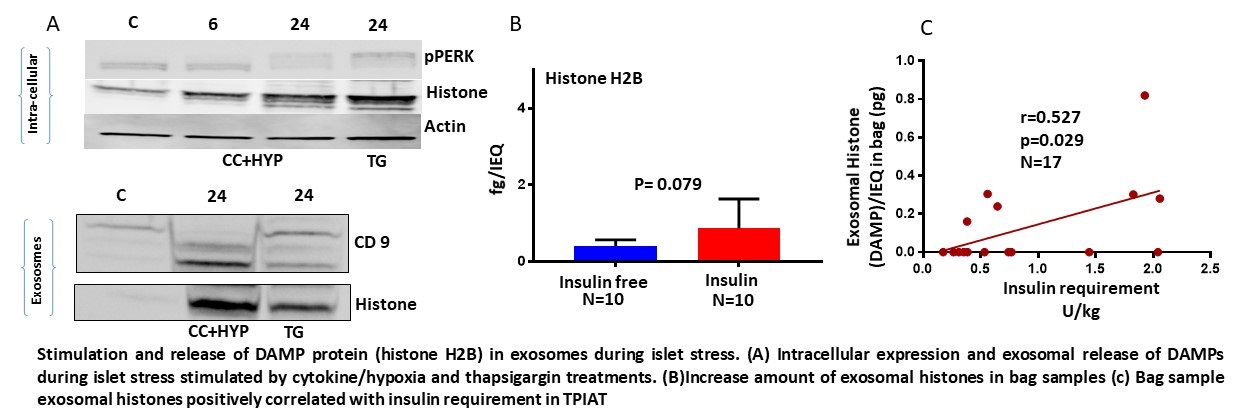Exosomal DAMP Proteins Released During Islet Isolation Affects TPIAT Outcomes
Hume Lee Islet Cell Transplantation Lab, Department of Surgery, VCU Health, Richmond, VA
Meeting: 2021 American Transplant Congress
Abstract number: 461
Keywords: Inflammation, Islets, Outcome, Tumor necrosis factor (TNF)
Session Information
Session Time: 7:30pm-8:30pm
 Presentation Time: 7:40pm-7:50pm
Presentation Time: 7:40pm-7:50pm
Location: Virtual
*Purpose: Isolation of islets cause significant stress that results in the release of immunogenic factors called damage-associated molecular patterns (DAMPs) which can induce inflammatory signaling that results in post-transplant islet damage. Here, we sought to identify these DAMPs released by islets via exosomes during islet isolation and also study their effect on TPIAT outcomes.
*Methods: Post-transplant stress was mimicked in vitro by exposing human islets to hypoxia and cytokines (Cyt+Hyp) simultaneously for 24h. Separately, human islets were also treated with thapsigargin (TG) for 24hrs to induce ER stress. Exosomes were isolated and the differentially expressed proteins were determined by mass spectrometry and western blotting. Exosomes were also isolated from the transplant media (infusion bag) of TPIAT patients to measure DAMP protein levels in them. Patients receiving an islet dose of 4000IEQ/kg were divided into insulin-dependent (ID; n=10) and insulin-independent (IID; n=10) groups. The exosomal DAMP protein levels were correlated with 1-year TPIAT outcomes
*Results: The number of exosomes released was significantly elevated in (Cyt+Hyp) treated islets compared to untreated islets. The mass spectrometry analysis has revealed about 17 proteins including DAMP protein histones (H2A, H2B, H4) and Keratins (Type I and II) were differentially expressed. Islets treated with thapsigargin or Cyt+Hyp overexpressed histones and keratins intracellularly through the activation of the PERK/IRE1α pathway. This subsequently led to the increased release of histones and keratins via exosomes during stress (Figure A). Exosomes isolated from transplant media of TPIAT patients showed elevated histone (p=0.0796) (Figure B) and decreased keratin (p=0.072) in ID compared to IID patients. Moreover, high exosomal histone/IEQ correlated with increased insulin requirement (r=0.527, p=0.029 n=17) (Figure: C) and HBA1c%, and lower c-peptide (r=-0.494, p=0.085 n=13) and SUITO index at 1-year POD. In contrast, the exosomal keratin/IEQ showed the opposite effect on 1-year outcomes
*Conclusions: The study has identified the exosomal DAMP protein-like histones are produced by the stressed islets during islet isolation which is capable to induce islet inflammation and graft loss in TPIAT. The elevated quantity of such exosomal DAMP proteins in the bag samples correlated with the poor transplant outcomes in TPIAT
To cite this abstract in AMA style:
Saravanan P, Kalivarathan J, Levy M, Kanak M. Exosomal DAMP Proteins Released During Islet Isolation Affects TPIAT Outcomes [abstract]. Am J Transplant. 2021; 21 (suppl 3). https://atcmeetingabstracts.com/abstract/exosomal-damp-proteins-released-during-islet-isolation-affects-tpiat-outcomes/. Accessed December 24, 2025.« Back to 2021 American Transplant Congress

